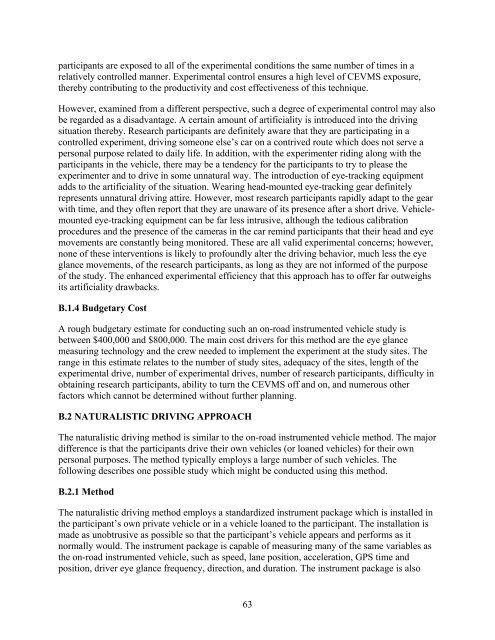The Effects of Commercial Electronic Variable Message Signs ...
The Effects of Commercial Electronic Variable Message Signs ...
The Effects of Commercial Electronic Variable Message Signs ...
Create successful ePaper yourself
Turn your PDF publications into a flip-book with our unique Google optimized e-Paper software.
participants are exposed to all <strong>of</strong> the experimental conditions the same number <strong>of</strong> times in a<br />
relatively controlled manner. Experimental control ensures a high level <strong>of</strong> CEVMS exposure,<br />
thereby contributing to the productivity and cost effectiveness <strong>of</strong> this technique.<br />
However, examined from a different perspective, such a degree <strong>of</strong> experimental control may also<br />
be regarded as a disadvantage. A certain amount <strong>of</strong> artificiality is introduced into the driving<br />
situation thereby. Research participants are definitely aware that they are participating in a<br />
controlled experiment, driving someone else’s car on a contrived route which does not serve a<br />
personal purpose related to daily life. In addition, with the experimenter riding along with the<br />
participants in the vehicle, there may be a tendency for the participants to try to please the<br />
experimenter and to drive in some unnatural way. <strong>The</strong> introduction <strong>of</strong> eye-tracking equipment<br />
adds to the artificiality <strong>of</strong> the situation. Wearing head-mounted eye-tracking gear definitely<br />
represents unnatural driving attire. However, most research participants rapidly adapt to the gear<br />
with time, and they <strong>of</strong>ten report that they are unaware <strong>of</strong> its presence after a short drive. Vehiclemounted<br />
eye-tracking equipment can be far less intrusive, although the tedious calibration<br />
procedures and the presence <strong>of</strong> the cameras in the car remind participants that their head and eye<br />
movements are constantly being monitored. <strong>The</strong>se are all valid experimental concerns; however,<br />
none <strong>of</strong> these interventions is likely to pr<strong>of</strong>oundly alter the driving behavior, much less the eye<br />
glance movements, <strong>of</strong> the research participants, as long as they are not informed <strong>of</strong> the purpose<br />
<strong>of</strong> the study. <strong>The</strong> enhanced experimental efficiency that this approach has to <strong>of</strong>fer far outweighs<br />
its artificiality drawbacks.<br />
B.1.4 Budgetary Cost<br />
A rough budgetary estimate for conducting such an on-road instrumented vehicle study is<br />
between $400,000 and $800,000. <strong>The</strong> main cost drivers for this method are the eye glance<br />
measuring technology and the crew needed to implement the experiment at the study sites. <strong>The</strong><br />
range in this estimate relates to the number <strong>of</strong> study sites, adequacy <strong>of</strong> the sites, length <strong>of</strong> the<br />
experimental drive, number <strong>of</strong> experimental drives, number <strong>of</strong> research participants, difficulty in<br />
obtaining research participants, ability to turn the CEVMS <strong>of</strong>f and on, and numerous other<br />
factors which cannot be determined without further planning.<br />
B.2 NATURALISTIC DRIVING APPROACH<br />
<strong>The</strong> naturalistic driving method is similar to the on-road instrumented vehicle method. <strong>The</strong> major<br />
difference is that the participants drive their own vehicles (or loaned vehicles) for their own<br />
personal purposes. <strong>The</strong> method typically employs a large number <strong>of</strong> such vehicles. <strong>The</strong><br />
following describes one possible study which might be conducted using this method.<br />
B.2.1 Method<br />
<strong>The</strong> naturalistic driving method employs a standardized instrument package which is installed in<br />
the participant’s own private vehicle or in a vehicle loaned to the participant. <strong>The</strong> installation is<br />
made as unobtrusive as possible so that the participant’s vehicle appears and performs as it<br />
normally would. <strong>The</strong> instrument package is capable <strong>of</strong> measuring many <strong>of</strong> the same variables as<br />
the on-road instrumented vehicle, such as speed, lane position, acceleration, GPS time and<br />
position, driver eye glance frequency, direction, and duration. <strong>The</strong> instrument package is also<br />
63

















